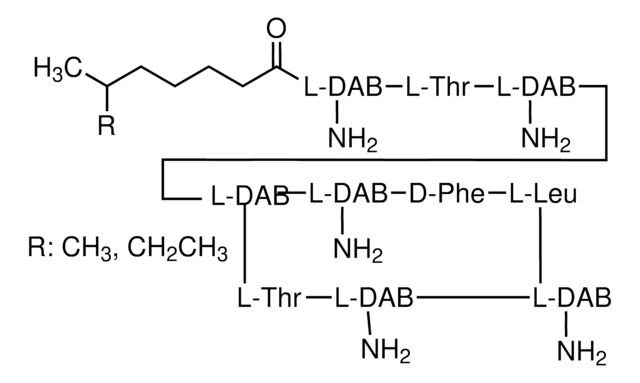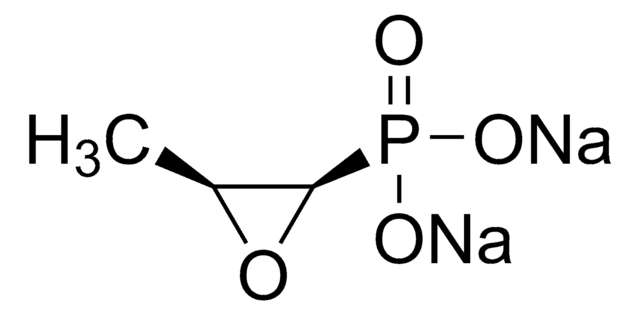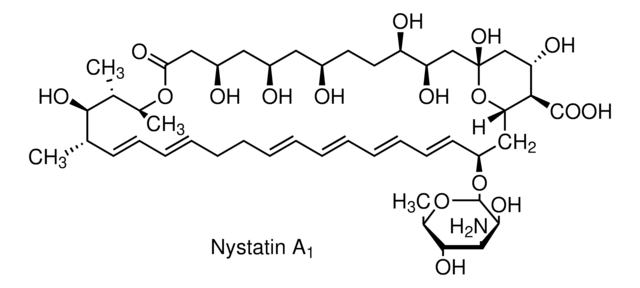A2411
Amphotéricine B from Streptomyces sp.
solid, suitable for cell culture, BioReagent
Synonyme(s) :
Fungizone
About This Item
Produits recommandés
Nom du produit
Amphotéricine B from Streptomyces sp., BioReagent, suitable for cell culture, ~80% (HPLC)
Source biologique
Streptomyces sp.
Niveau de qualité
Gamme de produits
BioReagent
Essai
~80% (HPLC)
Forme
solid
Puissance
>750.00 μg per mg (Dry basis)
Technique(s)
cell culture | mammalian: suitable
Couleur
yellow to yellow-orange
Solubilité
H2O: slightly soluble
Spectre d'activité de l'antibiotique
fungi
yeast
Mode d’action
cell membrane | interferes
Température de stockage
2-8°C
Chaîne SMILES
C[C@H]1O[C@@H](O[C@@H]2C[C@@H]3O[C@](O)(C[C@@H](O)C[C@@H](O)[C@H](O)CC[C@@H](O)C[C@@H](O)CC(=O)O[C@@H](C)[C@H](C)[C@H](O)[C@@H](C)\C=C\C=C\C=C\C=C\C=C\C=C\C=C\2)C[C@H](O)[C@H]3C(O)=O)[C@@H](O)[C@@H](N)[C@@H]1O
InChI
1S/C47H73NO17/c1-27-17-15-13-11-9-7-5-6-8-10-12-14-16-18-34(64-46-44(58)41(48)43(57)30(4)63-46)24-38-40(45(59)60)37(54)26-47(61,65-38)25-33(51)22-36(53)35(52)20-19-31(49)21-32(50)23-39(55)62-29(3)28(2)42(27)56/h5-18,27-38,40-44,46,49-54,56-58,61H,19-26,48H2,1-4H3,(H,59,60)/b6-5+,9-7+,10-8+,13-11+,14-12+,17-15+,18-16+/t27-,28-,29-,30+,31+,32+,33-,34-,35+,36+,37-,38-,40+,41-,42+,43+,44-,46-,47+/m0/s1
Clé InChI
APKFDSVGJQXUKY-INPOYWNPSA-N
Vous recherchez des produits similaires ? Visite Guide de comparaison des produits
Catégories apparentées
Description générale
Application
Actions biochimiques/physiologiques
Attention
Notes préparatoires
Autres remarques
Mention d'avertissement
Danger
Mentions de danger
Conseils de prudence
Classification des risques
STOT RE 1
Code de la classe de stockage
6.1C - Combustible acute toxic Cat.3 / toxic compounds or compounds which causing chronic effects
Classe de danger pour l'eau (WGK)
WGK 3
Point d'éclair (°F)
Not applicable
Point d'éclair (°C)
Not applicable
Équipement de protection individuelle
dust mask type N95 (US), Eyeshields, Gloves
Faites votre choix parmi les versions les plus récentes :
Déjà en possession de ce produit ?
Retrouvez la documentation relative aux produits que vous avez récemment achetés dans la Bibliothèque de documents.
Les clients ont également consulté
Articles
Prevent fungal, yeast, and mold contamination in cell cultures. Discover the best antifungal agent for your cultures with the extensive Sigma® antifungal collection.
Antibiotic kill curve is a dose response experiment in which mammalian cells are subjected to increasing amounts of selection antibiotic
Notre équipe de scientifiques dispose d'une expérience dans tous les secteurs de la recherche, notamment en sciences de la vie, science des matériaux, synthèse chimique, chromatographie, analyse et dans de nombreux autres domaines..
Contacter notre Service technique













